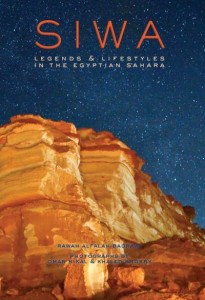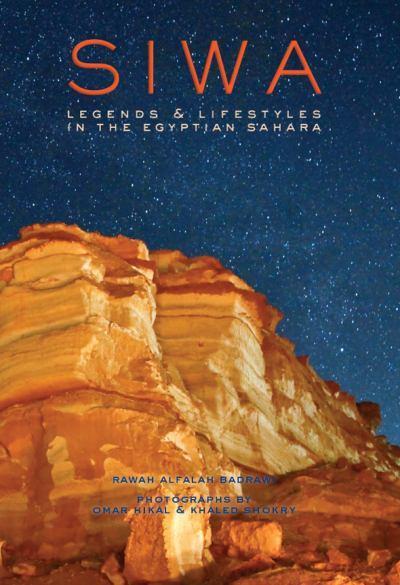
Siwa: Legends and Lifestyles in the Egyptian Sahara, by Rawah Alfalah Badrawi, photographs by Omar Hikal and Khaled Shokry. Hong Kong: Haven Books.146pp.
What could be enticing about a nine hour drive through barren land without fast food stops along the way and the possibility of running out of fuel? “Getting to Siwa is a story in itself,” says author Rawah Alfalah Badrawi.
Undoubtedly, part of Siwa’s draw is that it’s a destination only worthy of a few bold travellers who dare to attempt the journey, as explained during a book signing event that took place at Diwan Bookstore in Maadi last month. But the rewards are many, Badrawi went on, and far-ranging: as refreshing as the jolt in landscape from beige to green upon arriving in this desert oasis near Egypt’s Libyan border, as exciting as the settlement’s ancient history, or as soothing as the Sufi zikr chants echoing from the mountains of this spiritual town.
Knowing that many people have never braved the journey, Badrawi and photographers Omar Hikal and Khaled Shokry intended for their Siwa: Legends and Lifestyles in the Egyptian Sahara to be much more than just pretty pictures in the form of a coffee table book.
As a result, their photographic memoir is both part artistic treatise, and part passionate love letter to Siwa, capturing its multifaceted allure while tempting and challenging voyeurs to wander off the tired Egyptian tourist trail to satisfy a curiosity for unexpected adventure.
The collaborators (minus Hikal, who was abroad) brought the book to life during a signing in Diwan Bookstore in Maadi on Sunday, which happened to be attended by several visiting American college students eager to be educated on an Egypt that is rarely seen on television lately, if ever.
Badrawi and Shokry were not caught off guard and, mirroring their book, enthusiastically launched into a thorough lesson on the significant history, politics, heritage, and ecosystems of Siwa, garnering the foreigners’ rapt attention.
Throughout the beautifully designed and written book, they convey this very knowledge of Siwa as if it’s a secret too juicy to be kept to the self.
Their expertise comes from a long and deep labour of love in creating the book with Hikal. All three fell hard for Siwa at first sight on a trip there together in 2009, and have returned at least two more times since. “You don’t ever want to close your eyes in Siwa, from sunrises over the lake to starry nights in the desert,” says self-professed nature lover Shokry. “It provides infinite frames of beauty.”
For Badrawi, Siwa’s appeal is its novelty and variety of activities, from swimming in Lake Shiatta with flamingoes overhead, to sandboarding and camping in the desert. And for Hikal, Siwa provides something intangible that touches him deeply: “I love the serenity of Siwa. Liberated from the shackles of technology, we can immerse ourselves in our own dreams.”
Wanting more context to their experiences and the thousands of photographs Hikal and Shokry shot, Badrawi sought books on Siwa, and was shocked to find there were none.
“It’s unacceptable for such a national treasure to remain hidden, especially in the current state of Egypt’s economy and tourism,” says Badrawi. That’s why she chose an international publisher, Hong Kong based Haven Books, for the book over a local or regional one–to ensure worldwide distribution to prospective tourists.
With no airport or train or bus station, Shokry says Siwa is not meant to be a destination for mass tourism, nor is it the book’s aim to change that. The book does, however, hope to inspire pride and discovery, by both Egyptians and foreigners, of untapped potential around the country after the revolution.
Haven Books loved the idea of the book, especially since they had never had an Egyptian title before. Egyptian real estate company SODIC agreed to finance the publication on the basis that all proceeds would be used to fund initiatives in health, education and culture in Siwa. “After all that Siwans have shared with us, we want to give back to them and encourage others to visit and do the same in their own way,” says Badrawi.
Siwa’s population of less than 25,000 ethnic Berbers depends greatly on tourism, while remarkably maintaining its authenticity. They speak their own language, although some cultural customs are in danger of erosion by long-isolated Siwans’ desire for modernity, as relayed in the book by jewellery designer Azza Fahmy.
Fahmy and clothing designer Laila Nakhla, who have both lived and worked with Siwan women for years, shed important light on the very private community of women in a societal context. Frequent references to Dr. Mounir Neamatalla’s ecotourism efforts also underline the town’s environmental issues.
The book’s most delightful treat, besides the photographic feast for the eyes, is to read the heartfelt reflections on Siwa by Siwans themselves. The stunning simplicity, inspiring strength, beauty and spirituality of the Siwan people is best expressed in the own words of the salt, rope and stone artisans.
Other guest contributions by non-Siwans like Egyptian Prince Abbas Hilmi, a long-time Siwa resident, and Hollywood star Isabella Rossellini, a frequent visitor, explain the magnetic pull of Siwa for many seeking a getaway. As Hikal points out, “Siwa reminds us all—Egyptians and foreigners alike—of what once was, and gives us a chance to catch up with ourselves in a way no other place does.”
And finally, the book ends in a sweet surprise with a few modernized traditional Berber recipes to give readers enough of a taste of Siwa to have them craving it.
Through personal essays and stunning photography, Siwa: Legends and Lifestyles in the Egyptian Sahara dusts off this precious and rare Egyptian gem of a town, with every facet shining on every page.

